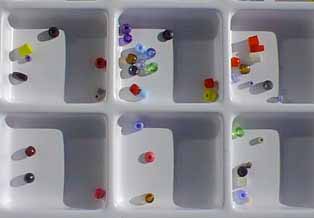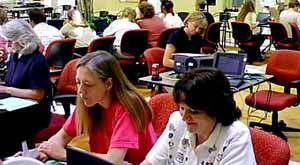|
|
| Vol 12|No 10|June|2003 | |
|
Please feel free to e-mail this article to a friend, a principal, a parent, a colleague, a teacher librarian, a college professor, a poet, a magician, a vendor, an artist, a juggler, a student, a news reporter or anyone you think might enjoy it. Other transmissions and duplications not permitted. (See copyright statement below).
After twenty years of using computers with students, some schools do not use these tools in ways that might enhance writing performance.
Few districts have provided the robust professional development to give teachers an adequate understanding of how to use these tools. A well designed course would introduce three key strategies for effective writing with computers:
Writing as Process
Simple words. Powerful strategy. The new technologies may radically change writing, mostly for the better, but the improvement is not automatic by any means. In smokestack schools, writing was often confused with the process of putting words down on paper in the same structure as an outline prepared in advance with appropriate Roman numerals and capital letters representing the major ideas arranged in some logical fashion. Once a first draft was completed, the focus was often upon the correction of mechanical and grammatical errors. During the 1970s, writing as process - first appearing as the Bay Area Writing Project - pointed to a different view of writing, one which permitted a far longer period for incubation of ideas and thoughts, one which emphasized multiple versions, flexibility, audience, non-linear thinking and peer review. A basic tenet of this approach was the possibility that the best route to a good paper was not a straight line. In this approach, a writer was more like a gardener than a railroad engineer. Combined with the word processor and a program such as Inspiration™, writing as process offers the prospect of idea processing. The software programs provide greater fluidity and flexibility than other writing technologies. They support greater word play and association. The writer can try out dozens, even hundreds of variations until the resulting product is just right. The software actually makes thinking more powerful, as long as students are taught how to use it in that way. Unfortunately, the technology works little magic by itself. If the mechanics-driven approach to writing still dominates a school and department, the word processor will do little more than improve the appearance and mechanics of student writing. In the adult world, many professional writers found that electronic text permitted rapid, risk free early expression that could easily be cleaned up and modified later on. Writing, it soon became apparent, was not just what happened when you started moving a pen or began typing on a keyboard. Writing was also the development and refinement of ideas in one's mind. When someone ponders a writing challenge while showering, jogging or driving, that reflection is part of the writing process. If the same person sits down, types a word on the monitor and asks for synonyms, that is writing. If the person starts stringing words together into sentences, either mentally, on paper or on screen, all three are writing. In writing as process, fragments are collected as beautiful beads that might later be strung in some ordered sequences. There should be no early pressure for order and logic. The emphasis should be upon richness. The goal is to gather as many impressions, thoughts and insights as possible without feeling constrained by critical and analytical judgments. Electronic text, because of its fluidity and malleability, is a wonderful medium for writers and thinkers. What are the basic elements of such a strategy and how can a computer help? 1. Pre-WritingThis is a wide open spaces, blue sky phase.The goal is to generate and collect as many ideas, words and fragments as possible. Better to avoid sentences and paragraphs. Good time to sketch and play and scribble. No performance pressures. It is helpful to think of filling up a bead tray. We hold off stringing the beads until much later. 
During this stage students may make use of a program such as Inspiration™ to collect and play with words and ideas. The January 2003 issue of FNO outlined in some detail how cluster diagramming can support school research - "Inspired Investigations." Generally speaking, this is a good time to stay nonlinear. As the word processor may push too hard, too early for an orderly progression of ideas, the focus on logic and coherence can actually contribute to "writer's block" and other problems. Go to teacher workshop activity. 2. Enrichment & Incubation Once students have made their first word sketches and started filling up their bead trays, they begin ranging a bit further afield, seeking additions. They may go on a beach walk . . . or a flight of fancy . . . or a fancy flight. They seek experiences to deepen and enrich their first efforts. Some folks call these journeys of the imagination excursions. We allow our playful selves to explore and wander like children crossing a vast meadow. We open our selves to the many colors in the evening sky. We stir the soup pot of our subconscious so the best parts do not stick to the bottom. We cultivate a sense of wonder. Go to teacher workshop activity. 3. First Writings At this stage students begin stringing the beads they have collected. They start moving the bits and pieces around. Not afraid to mix metaphors, we hop, skip and jump about to see which words fit with which others. This is a time to move towards collections of phrases and an occasional sentence, but we continue to keep the fragments in a "state of flux." We begin to lay the pieces out in what starts to look like some order, but we are not bound by the sequence. We add to those ideas that invite our attention. We lose little time worrying over others. We do not sit and stare. We keep moving. We make every effort to suspend critical judgment here, waiting for a later stage to refine our language and our expression. In some ways this expansion is like the swelling of an accordion as it is pulled apart and filled with air (in this case words and ideas). Later we shall compress and refine. 4. Peer Review Once students have pulled their ideas into some semblance of order, they begin to share what they are building with a group of peers who have been taught how to offer supportive and constructive audience reactions. This stage is useful only if the peers avoid strong handed advice and criticism. Go to teacher workshop activity. 5. Additions & Alterations Now students apply synthesis skills to modifying the elements of what they have collected. They are especially interested in adding ingredients to complete the picture they are drawing or the argument they are making. In some ways this stage is akin to finishing up a jigsaw puzzle. They have put enough together to see the outlines of the finished product, but there are still missing pieces and work to be done. This is the time to add richness, flavor, depth and color. Go to teacher workshop activity. 6. Re-Writing:
Go to teacher workshop activity.
toolkit98/six.html Assessment Most states now ask students to demonstrate strong writing performance by responding to writing prompts that require imagination, logic and style.
If schools expect to growth in these skills, they must invest time and money in professional development that will build teacher capacity. Whether they stress new technologies or old ones, the key intervention is effective teaching. How are schools doing? Consider the results from NAEP - the National Assessment of Educational Progress at http://nces.ed.gov/nationsreportcard/writing/
|
|
Back to June Cover
Credits: The photographs were shot by Jamie McKenzie .
Copyright Policy: Materials published in From Now On may be duplicated in hard copy format if unchanged in format and content for educational, nonprofit school district and university use only and may also be sent from person to person by e-mail. This copyright statement must be included. All other uses, transmissions and duplications are prohibited unless permission is granted expressly. Showing these pages remotely through frames is not permitted.
FNO is applying for formal copyright registration for articles. Unauthorized abridgements are illegal.
|
 From Now On
From Now On



